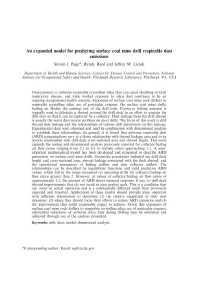Mining Publication: An Expanded Model for Predicting Surface Coal Mine Drill Respirable Dust Emissions
Original creation date: September 2008
Overexposure to airborne respirable crystalline silica dust can cause disabling or fatal respiratory disease, and mine worker exposure to silica dust continues to be an ongoing occupational health concern. Exposures of surface coal mine rock drillers to respirable crystalline silica are of particular concern. On surface coal mine drills, bailing air flushes the cuttings out of the drill hole. Conveyor belting material is typically used to fabricate a shroud around the drill deck in an effort to contain the drill dust so that it can be captured by a collector. Dust leakage from the drill shroud is usually the worst dust source problem on most drills. The focus of this work is drill shroud dust leakage and the relationships of various drill parameters on this leakage. Experimental data were obtained and used in combination with dimensional analysis to establish these relationships. In general, it is found that airborne respirable dust (ARD) concentrations vary in a direct relationship with shroud leakage area and in an inverse relationship with drill deck cross sectional area and shroud height. This work expands the testing and dimensional analysis previously reported for collector/bailing air flow ratios ranging from 2:1 to 4:1 to include ratios approaching 1:1. A semi empirical mathematical model has been developed and expanded to describe ARD generation on surface coal mine drills. Geometric parameters included are drill deck height and cross sectional area, shroud leakage associated with the deck shroud, and the operational parameters of bailing airflow and dust collector airflow. The relationships can be described by logarithmic functions and yield predictive ARD values, which fall in the range measured on operating drills for collector/bailing air flow ratios greater than 2. However, at values of collector/bailing air flow ratios of approximately 1.1, the amount of ARD shows minimal response, if any, to drill deck shroud improvements that do not result in near perfect seals. This is a condition that can occur in actual operation and is a substantially different result than previously expected and reported. Application of these results should provide mine operators with sufficient information to determine (1) the relative magnitude of their dust emissions, (2) where they should focus their efforts to reduce ARD emissions and (3) the improvement they could reasonably expect to achieve. Given that exposures of surface coal mine rock drillers to respirable crystalline silica are of particular concern, substantial reductions of airborne silica dust during drilling may be estimated and achieved through use of the analysis presented.
Authors: SJ Page, WR Reed, JM Listak
Peer Reviewed Journal Article - September 2008
NIOSHTIC2 Number: 20034509
Int J Min Reclam Environ, 2008; 22(3):210-221
See Also
- Best Practices for Controlling Respirable Dust in Coal Mines
- CFD Modeling in Processing Facilities
- Closing the Door to Dust When Adding Drill Steels: Uni-directional Cab Filtration and Pressurization System Tested
- The Effects of Low Quartz Mass Loading and Spatial Variability on the Quartz Analysis of Surface Coal Mine Dust Samples
- Evaluation of the Relative Importance of Coalbed Reservoir Parameters for Prediction of Methane Inflow Rates During Mining of Longwall Development Entries
- Field Assessment of Control Techniques and Long-Term Dust Variability for Surface Coal Mine Rock Drills and Bulldozers
- Field Evaluation of Air-blocking Shelf for Dust Control on Blasthole Drills
- Improved Drill Shroud Capture of Respirable Dust Utilizing Air Nozzles Underneath the Drill Deck
- Reducing Enclosed Cab Drill Operator's Respirable Dust Exposure at Surface Coal Operation With a Retrofitted Filtration and Pressurization System
- Reducing Enclosed Cab Drill Operator's Respirable Dust Exposure with Effective Filtration and Pressurization Techniques
- Content source: National Institute for Occupational Safety and Health, Mining Program


 ShareCompartir
ShareCompartir
